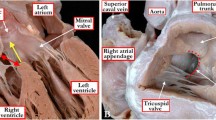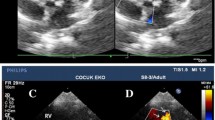Abstract
Between January 1987 and July 1989 a ventricular septal defect (VSD) as a single cardiac lesion was detected in 269 small infants aged less than 1 year. The diagnosis was achieved by two-dimensional echocardiography and Doppler colour flow mapping using subcostal, parasternal, apical, and suprasternal views. VSDs were divided into perimembraneous, muscular, malalignment, and subpulmonary defects. Septal defects in complex lesions and atrioventricular defects were excluded. In group 1 (174 infants up to 4 weeks of age, mean 10 days) 125 muscular (71.8%), 35 (20.1%) perimembraneous, 12 (6.9%) malalignment, and 2 (1.1%) subpulmonary defects were diagnosed. One baby had a combined perimembraneous and muscular defect. In another baby a malalignment defect was associated with an av-canal. In group 2 (95 infants aged 4 weeks to 1 year, mean 4.0 months), 57 (60%) muscular, 32 (33.6%) perimembraneous and 6 (6.3%) malalignment defects were found. Within the maximum observation period of 13 months, spontaneous closure occurred in 72 (42.6%) of 169 infants who had a sufficient follow up. Sixty-four had a muscular (88.9%) and 8 (11.1%) a perimembraneous defect. Surgical intervention was required in 11 patients: five perimembraneous defects were closed, one was palliated. Five infants with a malalignment defect were palliated. The malalignment defect frequently needed surgical intervention even in newborns; it never closed spontaneously. About 10% of patients with perimembraneous septal defect required surgery. Spontaneous closure rarely occurred in early infancy. Muscular VSDs were most frequent but virtually never required therapy. Spontaneous closure rate was about 50% during the 1st year of life.
Similar content being viewed by others
Abbreviations
- VSD:
-
ventricular septal defect
References
Alpert BS, Mellits ED, Rowe RD (1973) Spontaneous closure of small ventricular septal defects. Am J Dis Child 125:194–196
Becu LM, Fontana RS, DuShane JW, Kirklin JW, Burchell HB, Edwards JE (1956) Anatomic and physiologic studies in ventricular septal defect. Circulation 14:349
Bierman FZ, Fellows K, Williams RG (1980) Prospective identification of ventricular septal defects in infancy using subxiphoid two-dimensional echocardiography. Circulation 62: 807
Graham T, Bender HW, Spach MS (1983) In: Adams FH, Emmanouilides GC (eds) Moss heart disease in infants, children and adolescents, 3rd edn. Williams & Wilkins, Baltimore London, p. 134
Kapusta L, Hopman CW, Daniels O (1987) The usefullness of cross-sectional doppler flow imaging in the detection of small ventricular septal defects with left-to-right Shunt. Eur Heart J 8:1002–1006
Keith JD, Rowe RD, Vlad P (1967) Heart disease in infancy and childhood. MacMillan Company, New York, p 3
Kirklin JK, Castaneda AR, Keane JF, Fellows KE, Norwood WI (1980) Surgical management of multiple ventricular septal defects. J Thorac Cardiovasc Surg 80:485–493
Lincoln C, Jamieson S, Shinebourne E, Anderson RH (1977) Transatrial repair of ventricular septal defects with reference to their anatomic classification. J Thorac Cardiovasc Surg 74:183
Milo S, Ho SY, Wilkinson JL, Anderson RH (1980) Surgical anatomy and atrioventricular conduction tissues of hearts with isolated ventricular septal defects. J Thorac Cardiovasc Surg 79:244–255
Moe DG, Guntheroth WG (1987) Spontaneous closure of complicated ventricular septal defect. Am J Cardiol 60:674–678
Nadas AS, Fyler DC (1972) Pediatric cardiology, 3rd edn. Saunders, Philadelphia, p 348
Ortiz E, Robinson PJ, Deanfield JE (1985) Localisation of ventricular septal defects by simultaneous display of superimposed colour Doppler and cross sectional echocardiographic images. Br Heart J 54:53
Sutherland GR, Godman MJ, Smallhorn JF (1982) Ventricular septal defects: two-dimensional echocardiographic and morphologic correlations. Br Heart J 47:316
Swensson RE, Sahn DJ, Valdes-Cruz LM (1985) Color-flow Doppler mapping in congenital neart disease. Echocardiography 2:545
VanHare GF, Soffer LJ, Sivakoff MC, Liebmann J (1987) Twenty-five-year experience with ventricular septal defect in infants and children. Am Heart J 114:606–614
Wennik ACG, Oppenheimer-Decker A, Moulaert AJ (1979) Muscular ventricular defects: a reappraisal of the anatomy. Am J Cardiol 43:259–264
Williams RC, Bierman FZ, Sanders SP (1986) Echocardiographic diagnosis of cardiac malformations. Little, Brown and Company, Boston, p 51
Wippermann CF, Redel DA, Menschik T, Weinzheimer HR (1986) Die Lokalisation von Defekten im interventrikulären Septum — eine Studie mittels Farbdopplerechokardiographie. Monatsschr Kinderheilkd 134:602
Wittlich N, Erbel R, Drexler M, Mohr-Kahaly S, Brennecke R, Meyer J (1988) Colour-Doppler flow mapping of the heart in normal subjects. Echocardiography 5:157–172
Author information
Authors and Affiliations
Rights and permissions
About this article
Cite this article
Trowitzsch, E., Braun, W., Stute, M. et al. Diagnosis, therapy, and outcome of ventricular septal defects in the 1st year of life: A two-dimensional colour-Doppler echocardiography study. Eur J Pediatr 149, 758–761 (1990). https://doi.org/10.1007/BF01957273
Received:
Accepted:
Issue Date:
DOI: https://doi.org/10.1007/BF01957273




